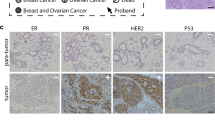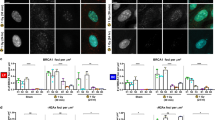Abstract
Inheritance of germ-line mutant alleles of BRCA1 and BRCA2 confers a markedly increased risk of breast cancer and we have previously reported a higher incidence of p53 mutations in these tumours than in grade matched sporadic tumours. We have now characterized these p53 mutants. The results of these studies identify a novel class of p53 mutants previously undescribed in human cancer yet with multiple occurrences in BRCA-associated tumours which retain a profile of p53-dependent activities in terms of transactivation, growth suppression and apoptosis induction which is close or equal to wild-type. However, these mutants fail to suppress transformation and exhibit gain of function transforming activity in rat embryo fibroblasts. These mutants therefore fall into a novel category of p53 mutants which dissociate transformation suppression from other wild-type functions. The rarity of these mutants in human cancer and their multiple occurrence in BRCA-associated breast tumours suggests that these novel p53 mutants are selected during malignant progression in the unique genetic background of BRCA1- and BRCA2-associated tumours.
This is a preview of subscription content, access via your institution
Access options
Subscribe to this journal
Receive 50 print issues and online access
$259.00 per year
only $5.18 per issue
Buy this article
- Purchase on Springer Link
- Instant access to full article PDF
Prices may be subject to local taxes which are calculated during checkout






Similar content being viewed by others
References
Brugarolas J and Jacks T. . 1997 Nature Med. 3: 721–722.
Caelles C, Helmberg A and Karin M. . 1994 Nature 370: 220–223.
Collins N, McManus R, Wooster R, Mangion J, Seal S, Lakhani SR, Ormiston W, Daly PA, Ford D, Easton D and Stratton MR. . 1995 Oncogene 10: 1673–1675.
Connor F, Bertwistle D, Mee PJ, Ross GM, Swift S, Grigorieva E, Tybulewicz VL, Ashworth A. . 1997 Nature Genetics 17: 423–430.
Crook T, Fisher C and Vousden KH. . 1991 J. Virol. 65: 505–510.
Crook T, Marston N, Sara E and Vousden KH. . 1994 Cell 79: 817–827.
Crook T, Crossland S, Crompton MR, Osin P and Gusterson BA. . 1997 Lancet 350: 638–639.
Crook T, Parker GA, Rozycka M, Crossland S and Allday MJ. . 1998a Oncogene 16: 1429–1441.
Crook TR, Brooks LA, Crossland S, Osin P, Barker KT, Waller J, Philp E, Smith PD, Yulug I, Peto J, Parker G, Allday MJ, Crompton MR and Gusterson BA. . 1998b Oncogene 17: 1681–1689.
El-Deiry WS, Harper JW, O'Connor PM, Velculescu VE, Canman CE, Jackman J, Pientenpol JA, Burrell M, Hill DE, Wang Y, Wilman KG, Mercer WE, Kastan MB, Kohn KW, Elledge SJ, Kinzler KW and Vogelstein B. . 1994 Cancer Res. 54: 1169–1174.
Fredersdorf S, Milne AW, Hall PA and Lu X. . 1996 Am. J. Path. 148: 825–835.
Hakem R, de la Pompa JL, Sirard C, Mo R, Woo M, Hakem A et al. 1996 Cell 11: 1009–1023.
Hakem R, de la Pompa JL, Elia A, Potter J and Mak TW. . 1997 Nature Genetics 16: 298–301.
Haupt Y, Rowan S, Shaulian E, Vousden KH and Oren M. . 1995 Genes Dev. 9: 2170–2183.
Haupt Y, Maya R, Kazaz A and Oren M. . 1997 Nature 387: 296–299.
Kinzler KW and Vogelstein B. . 1997 Nature 386: 761–763.
Knudson CM, Tung KS, Tourtellotte WG, Brown GA and Korsmeyer SJ. . 1995 Science 270: 96–99.
Ko LJ and Prives C. . 1996 Genes Dev. 10: 1054–1072.
Kubbutat MHG, Jones SN and Vousden KH. . 1997 Nature 387: 299–303.
Levine AJ, Perry ME, Chang A, Silver A, Dittmer D, Wu M and Welsh D. . 1994 Br. J. Cancer 69: 409–416.
Lowe SW, Jacks T, Housman DE and Ruley HE. . 1994 Proc. Natl. Acad. Sci. USA 91: 2026–2030.
Ludwig T, Chapman DL, Papaioannou VE and Efstratiadis A. . 1997 Genes Dev. 11: 1126–1241.
Miki Y, Swensen J, Shattuck-Eidens D, Futreal PA, Harshman K, Tavtigian S, Liu Q, Cochran C, Bennet LM, Wei D, Bell R, Rosenthal J, Hussey C, Thanh T, McClure M, Frye C, Hattier T, Phelps R, Haugen-Strano A, Katcher H, Kazulo Y, Gholami Z, Shaffer D, Stone S, Bayer S, Wray C, Bogden R, Dayananth P, Ward J, Tonin P, Narod S, Bristow PK, Lai M, Barrett C, Lewis C, Neuhausen S, Cannon-Albright L, Goldger D, Wiseman R, Kamb A and Skolnick MH. . 1994 Science 266: 66–71.
Miyashita T and Reed JC. . 1995 Cell 80: 293–299.
Neuhausen SL and Marshall CJ. . 1994 Cancer Res. 54: 6069–6072.
Parker GA, Crook T, Bain M, Sara E, Farrell PJ and Allday MJ. . 1996 Oncogene 13: 2541–2549.
Patel KJ, Yu VPCC, Lee H, Corcoran A, Thistlethwaite FC, Evans MJ, College WH, Friedman LS, Ponder BAJ and Venkitaraman AR. . 1998 Mol. Cell 1: 347–357.
Polyak K, Xia Y, Zweier JL, Kinzler KW and Vogelstein B. . 1997 Nature 389: 300–305.
Rowan S, Ludwig RL, Haupt Y, Bates S, Lu X, Oren M and Vousden KH. . 1996 EMBO J. 15: 827–838.
Smith SA, Easton DF, Evans DGR and Ponder BAJ. . 1992 Nature Genetics 2: 128–131.
de Stanchina E, McCurrach ME, Zindy F, Shieh S-Y, Ferbeyre G, Samuelson AV, Prives C, Roussel MF, Sherr CJ and Lowe SW. . 1998 Genes Dev. 12: 2434–2442.
Stott FJ, Bates S, James MC, McConnell BB, Starborg M, Brookes S, Palmero I, Ryan K, Hara E, Vousden KH and Peters G. . 1998 EMBO J. 17: 5001–5014.
Suzuki A, de la Pompa JL, Hakem R, Elia A, Yoshida R, Mo R, Nishina H, Chuang T, Wakeham A, Itie A, Koo W, Billia P, Ho A, Fukumoto M, Hui CC and Mak TW. . 1997 Genes Dev. 11: 1242–1252.
The Breast Cancer Linkage Consortium. . 1997 Lancet 349: 1505–1510.
Wagner AJ, Kokontis JM and Hay N. . 1994 Genes Dev. 8: 2817–2830.
Walker KK and Levine AJ. . 1996 Proc. Natl. Acad. Sci. USA 93: 15335–15340.
Wooster R, Bignell G, Lancaster J, Swift S, Seal S, Mangion J, Collins N, Gregory S, Gumbs C, Micklem G, Barfoot R, Hamoudi R, Patel S, Rice C, Biggs P, Hashim Y, Smith A, Connor F, Arason A, Gudmundsson J, Ficenec D, Kelsell D, Ford D, Tonin P, Bishop DT, Spurr N, Ponder BAJ, Eeles R, Peto J, Devilee P, Cornelisse C, Lynch H, Narod S, Lenoir G, Egilsson V, Barkadottir RB, Easton DF, Bentley DR, Futreal PA, Ashworth A and Stratton MR. . 1996 Nature 378: 789–792.
Zhang H, Somasundaram K, Peng Y, Tian H, Zhang H, Bi D, Weber BL and El-Deiry WS. . 1998 Oncogene 16: 1713–1721.
Zindy F, Eischen CM, Randle DH, Kamijo T, Cleveland JL, Sherr CJ and Roussel MF. . 1998 Genes Dev. 12: 2424–2433.
Acknowledgements
We thank K Vousden for pCB6+173L, R Weinberg for pEJ6.6, B Vogelstein for Waf1 luciferase and PIG3 luciferase, J Reid for Bax luciferase, L Buckbinder for IGF BP3 Box A luciferase, Moshe Oren for MDM2 luciferase and Xin Lu for the anti-p21Waf1 antibody. T Crook is a Leopold Muller Fellow. J Waller is funded by US Army grant number DAMD17-94-4066, L Brooks is supported by the Medical Research Council, P Osin by the Gilbert Fellowship and G Parker by the Wellcome Trust. Various parts of the work were supported by the Cancer Research Campaign and Breakthrough Breast Cancer.
Author information
Authors and Affiliations
Rights and permissions
About this article
Cite this article
Smith, P., Crossland, S., Parker, G. et al. Novel p53 mutants selected in BRCA-associated tumours which dissociate transformation suppression from other wild-type p53 functions. Oncogene 18, 2451–2459 (1999). https://doi.org/10.1038/sj.onc.1202565
Received:
Revised:
Accepted:
Published:
Issue Date:
DOI: https://doi.org/10.1038/sj.onc.1202565
Keywords
This article is cited by
-
High prevalence of the MLH1 V384D germline mutation in patients with HER2-positive luminal B breast cancer
Scientific Reports (2019)
-
Recurrent TP53 missense mutation in cancer patients of Arab descent
Familial Cancer (2017)
-
N-Methyl-N-nitrosourea as a mammary carcinogenic agent
Tumor Biology (2015)
-
BRCA1 and BRCA2: different roles in a common pathway of genome protection
Nature Reviews Cancer (2012)
-
High frequency of complex TP53 mutations in CNS metastases from breast cancer
British Journal of Cancer (2012)



